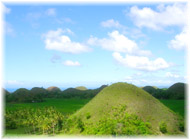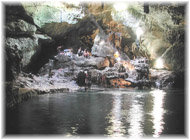Bohol
Tourist Attractions
Bohol Museum - Once the
residence of the country's fourth president, Carlos P. Garcia,
the Bohol Provincial Museum is Tagbilaran is a showcase of
the province's exciting history, culture and natural resources.
The Museum also houses the personal memorabilia of the late
president. Just a few minutes away from the Museum is the
Pres. Carlos P. Garcia Memorial Park where a life-sized monument
of the president stands. The statue was done by Boholanon
National Artist Napoleon Abueva in marble and bronze.
 Chocolate
Hills - Consisting of 1,268 haycock hills with heights
ranging from 40 to 120 meters, the Chocolate Hils is a wonder
of nature. RIghtly so, the Hills are considered as a Philippine
National Geological Monument. During the summer, the dome-shaped,
grass-covered limestone hills dry up and turn brown transforming
the areas into rows and rows of chocolate "kisses."
Indeed, a visit to Bohol is imcomplete without partaking of
the province's Peanut Kisses, crisp and crunchy delicacy made
of eggs and peanuts in honor of the wondrous hills.
Chocolate
Hills - Consisting of 1,268 haycock hills with heights
ranging from 40 to 120 meters, the Chocolate Hils is a wonder
of nature. RIghtly so, the Hills are considered as a Philippine
National Geological Monument. During the summer, the dome-shaped,
grass-covered limestone hills dry up and turn brown transforming
the areas into rows and rows of chocolate "kisses."
Indeed, a visit to Bohol is imcomplete without partaking of
the province's Peanut Kisses, crisp and crunchy delicacy made
of eggs and peanuts in honor of the wondrous hills.
Heritage Tour - An early
Spanish settlement, the province of Bohol is filled with old
churches, tree-lined plazas and ancestral houses. Visit the
Bohol Museum in Tagbilaran, the Punta Cruz Watch Tower in
Maribojoc (a wooden cross supposedly bestowed with mysterious
powers), the Baclayon Church, and the marker in Barrior Bool
commemorating Sikatuna and Legaspi's blood compact to complete
your trip down memory lane.
Hiking and Cycling - Bohol's
numerous hills, valleys and plateaus are ideal for hiking
and cycling. In Bilar, a three-kilometer man-made forest is
sanctuary to the province's endangered species including the
tarsier. The towns of Carmen, Batuan, and Sierra Bullones
possess cool weather throughout the year just right for long
and winding walks.
 Hinagdanan
Cave - With its breath-taking symphony of stalactites
and stalagmites jutting out of the earth, the Hinagdanan Cave
is certainly a sight to behold. Bring a swimsuit if you want
to swim its cool springs aptly lit from above by natural skylights.
Hinagdanan is only two and a-half kilometers from Dauis town.
Hinagdanan
Cave - With its breath-taking symphony of stalactites
and stalagmites jutting out of the earth, the Hinagdanan Cave
is certainly a sight to behold. Bring a swimsuit if you want
to swim its cool springs aptly lit from above by natural skylights.
Hinagdanan is only two and a-half kilometers from Dauis town.
Old Churches and Other Religious
Institution - One of the earliest Spanish settlements,
Bohol is home to one of the country's oldest stone churches,
the Baclayon Church. Built by the Jesuits, Baclayon features
a rich collection of religious articles from vestments woven
in gold thread to Latin librettos printed on sheepskin. The
legendary Dauis Church, which is just a few minutes from Tagbilaran
features a fresh water well at the foot of the altar. The
waters are said to be blessed with healing powers. Still another
religious must-see is the Panglao Church with its marvelous
ceiling murals and intricately-carved antique confessionals.
River Safari - Go on an
enchanting river tour. Bohol has four major rivers, INabanga
and Ipil in the north and Loboc and Abatan down south. From
Busay Falls, cruise down Loboc River in a pumpboat. Travel
through the seaside towns of Loboc, Loay and Bilar. On board
partake of a hearty lunch of fresh lapu-lapu, shrimp, and
squid to the tune of strumming guitars.
Swimming and Diving - To
top off this idyllic scenery, Bohol has also been blessed
with pristine white-sand beaches and serene dive spots. Panglao
Island has a number of beach resorts for sun lovers where
various watersports are available. Near Panglao are the island
of Balicasag and Pamilacan. Balicasag is considered as one
of the best dive spots in the country. The waters of Pamilacan
are brimming with schools of tuna, snappers, groupers, mackerel
and surgeonfish. Dolphins and pilot whales can also be viewed
from a distance.
 Tarsier
- The Philippine tarsier, (Tarsius syrichta) is very peculiar
small animal. In fact it is one of the smallest known primates,
no larger than a adult men's hand. Mostly active at night,
it lives on a diet of insects. Folk traditions sometimes has
it that tarsiers eat charcoal, but actually they retrieve
the insects from (sometimes burned) wood. It can be found
in the islands of Samar, Leyte, Bohol, and Mindanao in the
Philippines.
Tarsier
- The Philippine tarsier, (Tarsius syrichta) is very peculiar
small animal. In fact it is one of the smallest known primates,
no larger than a adult men's hand. Mostly active at night,
it lives on a diet of insects. Folk traditions sometimes has
it that tarsiers eat charcoal, but actually they retrieve
the insects from (sometimes burned) wood. It can be found
in the islands of Samar, Leyte, Bohol, and Mindanao in the
Philippines.
If no action is taken, the tarsier might
not survive. Although it is a protected species, and the practice
of catching them and then selling them as stuffed tarsiers
to tourists has stopped, the species is still threatened by
the destruction of his natural forest habitat. Many years
of both legal and illegal logging and slash-and-burn agriculture
have greatly reduced these forests, and reduced the tarsier
population to a dangerously small size. If no action is taken
now, the Philippine tarsier can soon be added to the list
of extinct species.